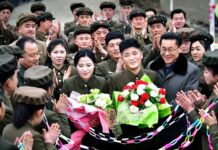Another article about “the strangest place on earth,” also one of the “greatest holidays on earth,” and an old question naturally comes to the surface: should tourists be going on vacation to North Korea?
The story of reporter Carole Cadwalladr’s trip to North Korea was published in The Observer on Sunday, February 14th. In it, the author describes her trip with Beijing-based, British-run Koryo Tours, one of the leaders in North Korea tourism; an article which the paper then ran alongside a similar article asking the same question of a different destination: should tourists be going on vacation to Burma?
The question is a tough one, but in the case of North Korea, the answer would be no, at least for now.
Where did The Obeserver’s reporter go in the North? The choices are, despite the best efforts of Koryo Tours to broaden the horizon, limited; in this case the Kim Il Sung mausoleum, the famed Kim Il Sung statue in Pyongyang, the International Friendship Exhibition at Mt. Myohang and the DMZ, not to mention those less tangible but no-less-fascinating locations: the city streets, the hotel bar and the dog meat soup restaurant.
In truth, everything in North Korea is fascinating to people from western countries. “A remarkable journey: like traveling through a Constable painting,” the article says of the train journey from Pyongyang to the border, and “an encounter that must qualify as the greatest touristic experience on earth,” it notes of the Kim Il Sung mausoleum.
However, there are big problems, from both the tourists’ and the human rights point of view. The agenda is fixed and largely immovable, there is limited opportunity for interaction with the North Korean people, and some of the destinations are so clearly propaganda sites that one is hard-pressed not to feel a little angry just being there (an ostrich farm on the outskirts of Pyongyang being a prime example). Equally, the broad avenues and relatively well-fed people in Pyongyang represent nothing more than a more believable form of propaganda, that of the so-called “showpiece capital city.” And when one watches the annual Arirang display, is one not watching one of the most brazen pieces of child exploitation in the modern world?
One key concern which stems from this is that the stories of weirdness spread by newspapers, websites and tourists’ personal blogs can end up shielding the public from the real situation in what is a very poor, very repressive society. Spreading word of the bizarre aspects of North Korea may be one way to reveal the nature of the country, making fun of the leader and the authorities, but it comes with the worry that the circumstances under which the people of North Korea are forced to live, which ought to be our primary concern, are being hidden behind a thick veneer of ridiculous caricatures of Kim Jong Il and his Pyongyang.
Burma, meanwhile, is a different experience. The agenda is not fixed in the same way and the propaganda is limited. The military regime may be as offensive as that in Pyongyang, but its methodology is different. People are poor, but free enterprise exists and tourists can interact with locals and travel more freely. With a little care, it is possible to channel spending into private hands. Burma is poor, the people need money, and through tourism, they have a chance of getting some. Some money does go to the state, it is pointless to try and pretend otherwise, but not all of it.
So, to call North Korea and Burma tourism equals is unwise. North Korean tourism is as tightly controlled as North Korea itself, while Burmese repression is more ramshackle, and more open to subversion. Therefore, while it would be good if everyone in the world were to take an interest in the situation in North Korea, the best way to achieve that is not, for the time being at least, to give the regime in Pyongyang foreign currency in this way.




















